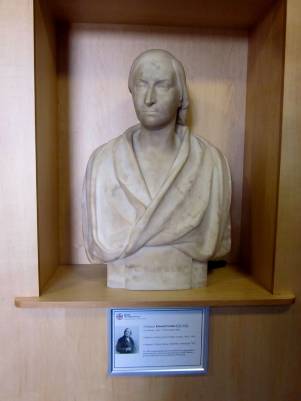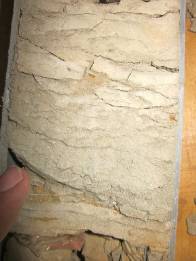There are colonies of cyclostomes and cheilostomes bryozoans with an exceptional preservation found on bivalve shells from the Red Crag Formation of Suffolk and Essex (SE England). This formation, as its name indicates, is red at outcrop, strongly oxidised, but unweathered samples from the subsurface are known to have a greenish colour. Therefore, to study green-coloured Red Crag samples is essential to determine the identity of the original iron-coating, oxidised to goethite in surface exposures.
Red Crag Formation at Butley, Suffolk, England
Bryozoans encrusting Glycymeris
The British Geological Survey keeps samples of these deposits in its core store. Therefore, to visit the BGS in Keyworth, Nottingham, was the first stage for this bryozoan research.
Professor Edward Forbes (1815-1854) welcomes you at the BGS. He was the first officer to be appointed as Palaeontologist to the Geological Survey of Great Britain
Seven cores were analized looking for mollusc shells, preferably shedding bryzoans from East Anglia.
Cores as they are preserved at the BGS
Colonies of cyclostome and cheilostome bryozoans are commoly found encrusting shells and are exquisitely preserved with delicate articulated spines and calcified opercula. They are placed on the undersides of the bivalves shells which gives them shelter. This only explains partially their preservation.
Exceptional fidelity preservation on Escharella aff. octodentata seen under SEM
As the calcified bryozoan skeletons are absent and the colonies are very finely preserved by thin coatings of rusty red-coloured goethite, these coatings must have formed very early in diagenesis. Currently its original mineralogy is unknown but may have been the same green mineral (glauconite and/or chlorite) that gives unweathered Red Crag. Conversion of this mineral to goethite was apparently accompanied by dissolution of the calcitic skeletons of the cyclostome and most of the cheilostome bryozoans.
Javier Cuadros taking samples for lab analysis









